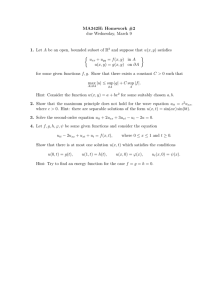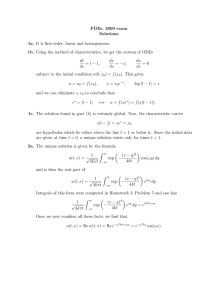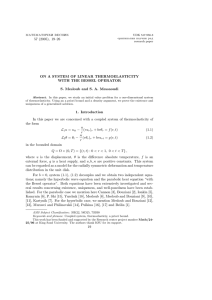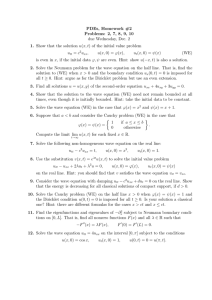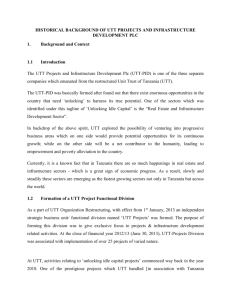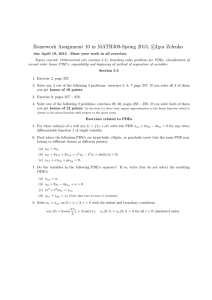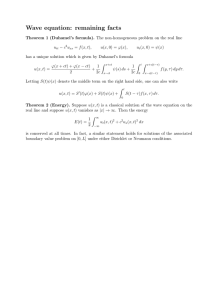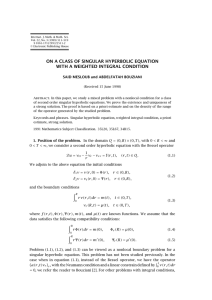1998(1998), No. 28, pp. 1–10. Electronic Journal of Differential Equations, Vol.
advertisement
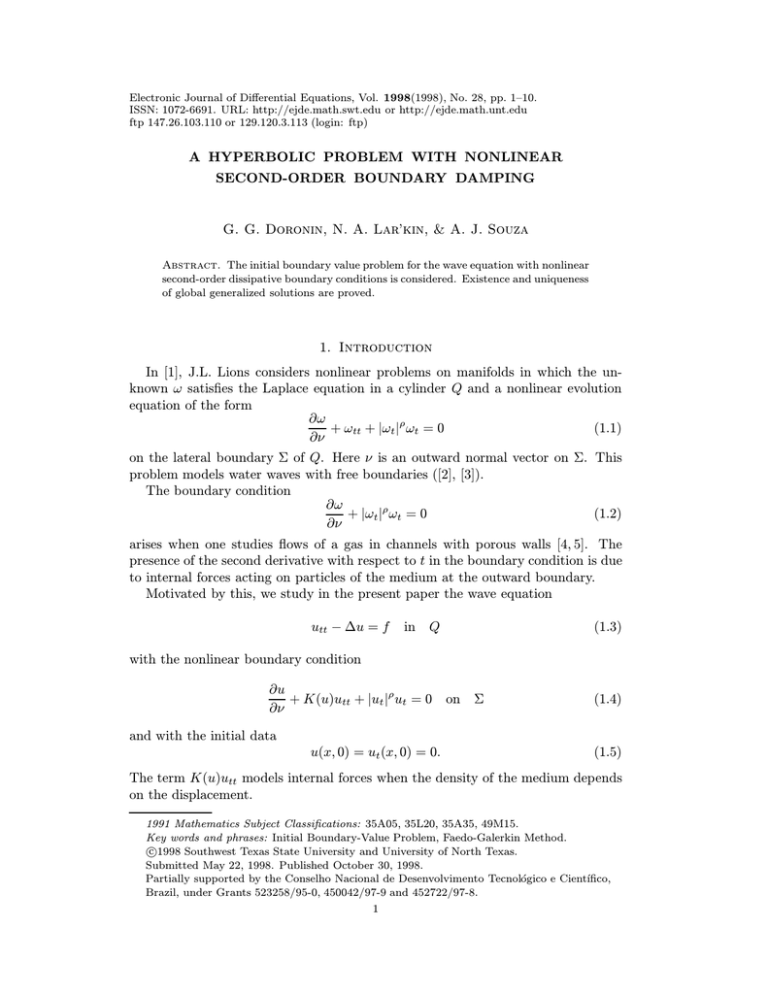
Electronic Journal of Differential Equations, Vol. 1998(1998), No. 28, pp. 1–10.
ISSN: 1072-6691. URL: http://ejde.math.swt.edu or http://ejde.math.unt.edu
ftp 147.26.103.110 or 129.120.3.113 (login: ftp)
A HYPERBOLIC PROBLEM WITH NONLINEAR
SECOND-ORDER BOUNDARY DAMPING
G. G. Doronin, N. A. Lar’kin, & A. J. Souza
Abstract. The initial boundary value problem for the wave equation with nonlinear
second-order dissipative boundary conditions is considered. Existence and uniqueness
of global generalized solutions are proved.
1. Introduction
In [1], J.L. Lions considers nonlinear problems on manifolds in which the unknown ω satisfies the Laplace equation in a cylinder Q and a nonlinear evolution
equation of the form
∂ω
(1.1)
+ ωtt + |ωt |ρ ωt = 0
∂ν
on the lateral boundary Σ of Q. Here ν is an outward normal vector on Σ. This
problem models water waves with free boundaries ([2], [3]).
The boundary condition
∂ω
(1.2)
+ |ωt |ρ ωt = 0
∂ν
arises when one studies flows of a gas in channels with porous walls [4, 5]. The
presence of the second derivative with respect to t in the boundary condition is due
to internal forces acting on particles of the medium at the outward boundary.
Motivated by this, we study in the present paper the wave equation
utt − ∆u = f
in
Q
(1.3)
with the nonlinear boundary condition
∂u
+ K(u)utt + |ut |ρ ut = 0
∂ν
on
Σ
(1.4)
and with the initial data
u(x, 0) = ut (x, 0) = 0.
(1.5)
The term K(u)utt models internal forces when the density of the medium depends
on the displacement.
1991 Mathematics Subject Classifications: 35A05, 35L20, 35A35, 49M15.
Key words and phrases: Initial Boundary-Value Problem, Faedo-Galerkin Method.
c
1998
Southwest Texas State University and University of North Texas.
Submitted May 22, 1998. Published October 30, 1998.
Partially supported by the Conselho Nacional de Desenvolvimento Tecnológico e Cientı́fico,
Brazil, under Grants 523258/95-0, 450042/97-9 and 452722/97-8.
1
2
G. G. Doronin, N. A. Lar’kin, & A. J. Souza
EJDE–1998/28
In [1] it is shown that (1.1) can be replaced by the evolution equation
utt + A(u) + |ut |ρ ut = 0
on
Σ,
where A is a linear positive self-adjoint operator. In that sense, the expression (1.2)
looks like a semilinear hyperbolic equation on the manifold Σ. Equation (1.4) also
behaves as a hyperbolic equation with nonlinear principal operator.
Generally speaking, quasilinear hyperbolic equations do not have global regular
solutions. There are examples of “blow-up” at a finite time. (See, for instance,
[6].) Nevertheless, the presence of linear damping allows proof of the existence of
global solutions for small initial data ([7]). Moreover, a nonlinear damping makes
it possible to prove global existence theorems for some quasilinear wave equations
without restrictions on a size of the initial conditions ([8], [9]).
Here we use the ideas from [8] to prove the existence of global generalized solutions to the problem (1.3)-(1.5). We exploit the Faedo-Galerkin method, a priori
estimates and compactness arguments. Uniqueness is proved in the one-dimensional
case.
We consider the classical wave equation only to simplify calculations. Similar
results hold for a second-order evolution equation of the form
utt + A(t)u + F (u, ut ) = f,
where A(t) is a linear, strictly elliptic operator, and F (u, ut ) is a suitable function of u and ut . Moreover, hyperbolic-parabolic or elliptic equations also may be
considered.
2. The Main Result
For T > 0, let Ω be a bounded open set of Rn with sufficiently smooth boundary
Γ and Q = Ω × (0, T ). We consider the hyperbolic problem
utt − ∆u = f (x, t) , (x, t) ∈ Q;
∂u
+ K(u)utt + |ut |ρ ut = 0; u|Σ0 = 0;
∂ν
Σ1
(2.1)
u(x, 0) = ut (x, 0) = 0.
(2.3)
(2.2)
Here K(u) is a continuously differentiable positive function; ν is the outward unit
normal vector on Γ; Γ = Γ0 ∪ Γ1 ; Γ0 ∩ Γ1 = ∅ ; Σi = Γi × (0, T ) (i = 0, 1);
ρ ∈ (1, ∞).
1
We denote
the condition u|Γ0 = 0;
R by H1 (Ω) the Sobolev space H (Ω) with
2
(u, v)(t) = Ω u(x, t)v(x, t) dx; ||u|| is the norm in L (Ω): ||u||2 (t) = (u, u)(t);
P
∆u = ni=1 ∂ 2 u/∂x2i .
Definition. A function u(x, t) such that
u ∈ L∞ (0, T ; H1 (Ω)),
ut ∈ L∞ (0, T ; H1 (Ω)) ∩ Lρ+2 (Σ1 ),
utt ∈ L∞ (0, T ; L2 (Ω) ∩ L2 (Γ1 )),
u(x, 0) = ut (x, 0) = 0
EJDE–1998/28
A hyperbolic problem
3
is a generalized solution to (2.1)-(2.3) if for any functions v ∈ H1 (Ω) ∩ Lρ+2 (Γ) and
ϕ ∈ C 1 (0, T ) with ϕ(T ) = 0 the following identity holds:
ZT
Z
ρ
(utt , v)(t) + (∇u, ∇v)(t) +
|ut | ut − K 0 (u)u2t v dΓ ϕ(t) dt
0
Γ1
ZT
−
ϕ0 (t)
0
(2.4)
ZT
Z
K(u)ut v dΓ dt =
(f, v)ϕ(t) dt .
0
Γ1
We consider functions K(u) satisfying the assumptions
0 < K0 ≤ K(u) ≤ C(1 + |u|ρ ),
|K 0 (u)|
ρ
ρ−1
≤ C(1 + K(u)).
(2.5)
(2.6)
These conditions mean that the density of the medium can not increase too rapidly
as a function of displacement. The condition (2.6) appears quite naturally because
functions with polynomial growth, such as K(u) = 1 + |u|s with 1 ≤ s ≤ ρ, satisfy
it. The inequality K(u) ≥ K0 means that the vacuum is forbidden.
The main result of this paper is the following.
Theorem. Let the function K(u) satisfy assumptions (2.5) and (2.6) and suppose
f (x, t) ∈ H 1 (0, T ; L2 (Ω)). Then for all T > 0 there exists at least one generalized
solution to the problem (2.1)-(2.3). If n = 1, this solution is unique.
Proof. We prove the existence part of the Theorem by the Faedo-Galerkin method.
First, we construct approximations of the generalized solution. Then we obtain a
priori estimates necessary to guarantee convergence of approximations. Finally, we
prove the uniqueness in the one-dimensional case.
3. Approximate solutions
Let {wj (x)} be a basis in H1 (Ω) ∩ Lρ+2 (Γ1 ). We define the approximations
uN (x, t) =
N
X
gi (t)wi (x),
(3.1)
i=1
where gi (t) are solutions to the Cauchy problem
N
(f, wj )(t) = (uN
tt , wj )(t) + (∇u , ∇wj )(t) +
Z
Γ1
N ρ N
K(uN )uN
wj dΓ ;
tt + |ut | ut
(3.2)
gj (0) = gj0 (0) = 0; j = 1, ..., N .
(3.3)
It can be seen that (3.2) is not a normal system of ODE; therefore, we can not
apply the Caratheodory theorem directly. To overcome this difficulty, we have to
prove that the matrix A defined by
)
Z (
N
X
00
00
N
00
(Ag )j = gj (t) +
K(u )
gi (t)wi (x) wj (x) dΓ ; j = 1, ..., N
(3.4)
Γ1
i=1
G. G. Doronin, N. A. Lar’kin, & A. J. Souza
4
EJDE–1998/28
has an inverse. Multiplying (3.2) by gj00 (t) and summing over j, we obtain the
quadratic form
N
N Z
X
X
00
(gj00 )2 +
q (g100 , ..., gN
)=
K(uN )wi wj dΓ gi00 gj00 .
j=1
i=1 Γ
1
The condition K(u) ≥ K0 > 0 implies that for any g00 (t) 6= 0
2
Z
N
N
N
X
X
X
00 2
N
00
2
q =
(gj ) + K(u )
gj wj
dΓ ≥
(gj00 )2 + K0 ||uN
tt ||L2 (Γ1 ) > 0.
j=1
j=1
Γ1
j=1
Hence, the quadratic form q is positive definite and all eigenvalues of the symmetric
matrix A in (3.4) are positive. Thus, (3.2) can be reduced to normal form and, by
the Caratheodory theorem, the problem (3.2),(3.4) has solutions gj (t) ∈ H 3 (0, tN )
and all the approximations (3.1) are defined in (0, tN ).
4. A priori estimates
Next, we need a priori estimates to show that tN = T and to pass to the limit
as N → ∞. To simplify the exposition, we omit the index N whenever it is
unambiguous to do so.
Multiplying (3.2) by 2gj0 and summing from j = 1 to j = N , we obtain
Z
d
2
2
2(f, ut )(t) =
||ut || + ||∇u|| (t) + 2 |ut |ρ+2 dΓ
dt
Γ1
Z d
2
0
3
+
dΓ .
K(u)ut − K (u)(ut )
dt
Γ1
Integrating with respect to τ from 0 to t, we get
Zt
2
(f, uτ ) dτ = ||ut ||2 + ||∇u||2 (t)
0
Zt Z ρ+2
|uτ |
+2
0 Γ1
Z
1 0
3
− K (u)(uτ ) dΓ dτ + K(u)u2t dΓ .
2
Γ1
Notice that
Zt Z
2
0 Γ1
Zt
Z
≥2
0 Γ1
1 0
ρ
|uτ | |uτ | − K (u)uτ dΓ dτ
2
2
n
o
ρ
|uτ |2 |uτ |ρ − ε|uτ |ρ − C(ε)|K 0 (u)| ρ−1 dΓ dτ ,
EJDE–1998/28
A hyperbolic problem
5
where ε is an arbitrary positive number. From now on, we denote by “C” all
constants independent of N .
Fixing ε = 1/2, taking into account (2.6), and applying the Cauchy-Schwarz
inequality, we get
2
2
||ut || + ||∇u||
Zt Z
(t) +
0 Γ1
Zt
≤
Z
|uτ |ρ+2 dΓ dτ +
K(u)u2t dΓ
Γ1
||f ||2 + ||uτ ||2 (τ ) dτ + C
0
Zt Z
(4.1)
|uτ |2 (1 + K(u)) dΓ dτ .
0 Γ1
Note that K(u) ≥ C0 (1 + K(u)) where 2C0 = min{1, K0 }. Therefore, for the
function
Z
E1 (t) = ||ut ||2 + ||∇u||2 (t) + C0 (1 + K(u))|ut |2 dΓ
Γ1
we have from (4.1) the inequality
E1 (t) ≤ C 1 +
Zt
E1 (τ ) dτ .
0
By Gronwall’s lemma, we conclude that, for all t ∈ (0, T ) and for all N ≥ 1,
E1 (t) ≤ C.
This and (4.1) give that for all t ∈ (0, T ),
Zt Z
|uτ |ρ+2 dΓ dτ ≤ C,
0 Γ1
Z
Γ1
2
K(uN )(uN
t ) dΓ ≤ C,
where C does not depend on N .
In order to obtain the second a priori estimate, we observe that
||utt ||(0) ≤ ||f ||(0);
Z
u2tt (x, 0)dΓ ≤ ||f ||2 /K(0).
(4.2)
(4.3)
Γ1
Indeed, multiplying (3.2) by gj00 (0), summing over j, and setting t = 0, we obtain
Z
(utt , utt )(0) +
Γ1
K(0)u2tt (x, 0) dΓ = (f, utt )(0)
G. G. Doronin, N. A. Lar’kin, & A. J. Souza
6
EJDE–1998/28
which implies (4.2). Consequently,
Z
K(0)u2tt (x, 0) dΓ ≤ ||f ||(0) · ||utt ||(0) ≤ ||f ||2 (0),
Γ1
which gives (4.3).
Differentiating (3.2) with respect to t, multiplying by gj00 , and summing over j,
we obtain the identity
(ft , utt )(t) =
1 d
||utt ||2 + ||∇ut ||2 (t)
2 dt
Z
+
K(u)utt uttt + K 0 (u)ut u2tt + (ρ + 1)|ut |ρ u2tt dΓ .
Γ1
Notice that
K(u)utt uttt =
and
1
1 d
K (u) u2tt − K 0 (u)ut u2tt
2 dt
2
Z
Z
Z
ρ
K 0 (u)ut u2tt dΓ ≤ε |ut |ρ |utt |2 dΓ + C(ε) |K 0 (u)| ρ−1 · |utt |2 dΓ
Γ1
Γ1
Γ1
Z
Z
ρ
2
≤ε |ut | |utt | dΓ + C(ε) (1 + K(u))|utt |2 dΓ .
Γ1
Γ1
Setting ε = ρ, we have
Z
Z
1 d
2
2
2
||utt || + ||∇ut || + K(u)utt dΓ (t) + |ut |ρ |utt |2 dΓ
2 dt
Γ1
Γ1
Z
≤ ||ft ||2 + ||utt ||2 (t) + C (1 + K(u))|utt |2 dΓ .
Γ1
Defining E2 (t) as
E2 (t) = ||utt ||2 + ||∇ut ||2 + C0
Z
(1 + K(u))|utt |2 dΓ (t)
Γ1
and taking into account (4.2), (4.3), we reduce (4.4) to the form
Zt
E2 (t) ≤ C 1 + E2 (τ )dτ .
0
By Gronwall’s lemma, for all t ∈ (0, T ), N ≥ 1 we obtain
E2 (t) ≤ C .
(4.4)
EJDE–1998/28
A hyperbolic problem
7
Taking into consideration that u|Σ0 = 0, we obtain the following statements
uN ∈ L∞ (0, T ; H 1 (Ω));
∞
1
ρ+2
uN
(Σ) ∩ L∞ (0, T ; L2 (Γ));
t ∈ L (0, T ; H (Ω)) ∩ L
∞
2
2
uN
tt ∈ L (0, T ; L (Ω) ∩ L (Γ));
∂ N 1+ρ/2
∈ L2 (Σ);
|u |
∂t t
∞
2
K 1/2 (uN )uN
tt ∈ L (0, T ; L (Γ)).
(4.5)
5. Passage to the limit
Multiply (3.2) by ϕ ∈ C 1 (0, T ) with ϕ(T ) = 0 and integrate with respect to t
from 0 to T . After integration by parts, we obtain
ZT
Z
N
ρ N
(uN
|uN
ϕ(t) dt
tt , wj ) + (∇u , ∇wj ) +
t | ut wj dΓ
0
Γ1
ZT
−
Z
ϕ0 (t)
0
Γ1
ZT
Z
−
ϕ(t)
0
N
N T
K(uN )uN
t wj (x) dΓ dt + ϕ(t)K(u )ut |0
0
K (u
N
2
)(uN
t ) wj
(5.1)
ZT
dΓ dt =
(f, wj )ϕ(t) dt.
0
Γ1
Because of (4.5) we can extract a subsequence uµ from uN such that:
uµ → u weakly star in L∞ (0, T ; H1 (Ω));
uµt → ut weakly star in L∞ (0, T ; H1 (Ω)) ∩ Lρ+2 (Σ);
uµtt → utt weakly star in L∞ (0, T ; L2 (Ω) ∩ L2 (Γ));
uµ , uµt → u, ut
a.e. on Σ.
Therefore,
|uµt |ρ uµt ∈ Lq (Σ), q = (ρ + 2)/(ρ + 1) > 1, and converges a.e. on Σ;
K(uµ )uµt ∈ Lq (Σ),
K 0 (uµ )(uµt )2 ∈ Lq (Σ),
and converges a.e. on Σ;
and converges a.e. on Σ.
Thus, we are able to pass to the limit in (5.1) to obtain
ZT
Z
(u , w ) + (∇u, ∇wj ) +
tt j
0
|ut |ρ ut − K 0 (u)u2t wj dΓ
Γ1
ZT
−
0
ϕ0 (t)
Γ1
K(u)ut wj dΓ dt =
(f, wj )ϕ(t) dt .
0
ϕ(t) dt
(5.2)
ZT
Z
G. G. Doronin, N. A. Lar’kin, & A. J. Souza
8
EJDE–1998/28
It can be seen that all the integrals in (5.2) are defined for any function ϕ(t) ∈
C 1 (0, T ), ϕ(T ) = 0. Taking into account that {wj (x)} is dense in H 1 (Ω)∩Lρ+2 (Γ),
we conclude that (2.4) holds.
If n = 1, 2, one can get more regular solutions. In this case u ∈ L∞ (0, T ; Lq (Γ))
for any q ∈ [1, ∞). Hence, K(u)utt ∈ L∞ (0, T ; Lp (Γ)), where p is an arbitrary
number from the interval [1, 2). This allows us to rewrite (5.2) in the form
ZT
ZT
Z
(utt , wj ) + (∇u, ∇wj ) + (K(u)utt + |ut |ρ ut ) wj dΓ ϕ(t) dt.
(f, wj ) dt =
0
0
Γ1
Taking into account that almost every point t ∈ (0, T ) is a Lebesgue point and
that wj (x) are dense in H 1 (Ω) and therefore in Lq (Γ), we obtain
Z
(utt , v)(t) + (∇u, ∇v)(t) +
{K(u)utt + |ut |ρ ut }v dΓ = (f, v)(t),
Γ1
where v is an arbitrary function from H 1 (Ω).
6. Uniqueness
Let n = 1. Let u and v be two solutions to (2.1)-(2.3), and set z(x, t) = u(x, t) −
v(x, t). Then for fixed t, for every function φ ∈ H1 (Ω), we have
Z
+
(ztt , φ)(t) + (∇z, ∇φ)(t)
{K(u)ztt + vtt (K(u) − K(v)) + |ut |ρ ut − |vt |ρ vt } φ dΓ = 0 .
Γ1
Since zt (x, t) ∈ L∞ (0, T ; H1 (Ω)), we may take φ = zt , and this equation can be
reduced to the inequality
Z
1 d
E(t) + K(u)(zt )2 dΓ
2 dt
Γ1
Z 1 0
2
+
vtt zt (K(u) − K(v)) − K (u)ut (zt )
dΓ ≤ 0 .
2
Γ1
Here we set E(t) = kzt k2 (t) + k∇zk2 (t) and use the monotonicity of |ut |ρ ut , the
differentiability of K, and the regularity of K(u)utt (see the end of previous section).
Condition (2.6) then implies that
Z
1 d
E(t) + K(u)(zt )2 dΓ
2 dt
Γ1
Z
Z
ρ−1
1 2
≤C max(1 + K(u)) ρ |ut | (zt )2 dΓ +
|zt | + |vtt |2 |K(u) − K(v)|2 dΓ
Γ1
2
Γ1
Γ1
Z
Z
≤C |zt |2 dΓ + max |K(u) − K(v)|2 |vtt |2 dΓ
Γ1
Γ1
≤C1 kzt k2L2 (Γ1 )
+
C2 kvtt k2L2 (Γ1 )
Γ1
·
kzk2C(Γ1 )
.
EJDE–1998/28
A hyperbolic problem
9
Integrating from 0 to t, using (2.5) and the Sobolev embedding theorem ([10]), we
obtain
2
2
kzt k (t) + k∇zk (t) +
kzt k2L2 (Γ1 ) (t)
≤C
Zt h
i
kzt k2L2 (Γ1 ) (τ ) + k∇zk2 (τ ) dτ .
0
This implies that kzk = 0 and u = v a.e. in Q. The proof of the Theorem is
completed.
Remark. We use homogeneous initial conditions (2.3) for technical reasons. Nonhomogeneous initial data also can be considered without any restrictions on their
size ([10]). In fact, suppose that initial conditions are imposed as follows
u(x, 0) = u0 (x),
ut (x, 0) = u1 (x),
x ∈ Ω.
Using the transformation v(x, t) = u(x, t) − u0 (x) − u1 (x) · t, we obtain the
problem
vtt − ∆v = F (x, t)
in Q;
(6.1)
∂v
∂φ
+
+ K(v + φ)vtt + |vt + u1 |ρ (vt + u1 ) = 0 on Σ1 ;
∂ν
∂ν
v+φ=0
on Σ0 ;
(6.3)
v(x, 0) = vt (x, 0) = 0 in Ω.
(6.4)
(6.2)
Here φ(x, t) = u0 (x) + u1 (x) · t and F (x, t) = (f + ∆φ)(x, t) are given functions.
It is clear that for regular solutions the compatibility conditions
∂u0
+ K(u0 )(f + ∆u0 ) + |u1 |ρ u1 |Γ1 = 0;
∂ν
u0 |Γ0 = 0
need to be satisfied. This implies that conditions (6.2)-(6.4) are also compatible.
If (u0 , u1 )(x) ∈ H 2 (Ω), than F (x, t) ∈ H 1 (0, T ; L2 (Ω)). Moreover, if u1 ∈
ρ+2
L (Γ1 ), then we are able to obtain necessary a priori estimates and to pass to
the limit by the method of Sections 4 and 5. Of course, the use of conditions (6.2),
(6.3) in place of (2.2) complicates calculations, but does not affect the final result.
Acknowledgments. We thank the referee for his/her valuable suggestions.
REFERENCES
[1] Lions, J.-L., Quelques méthodes de résolution des problèmas aux limites non
linéaires, Paris, Dunod, 1969.
[2] Garipov, R.M., On the linear theory of gravity waves: the theorem of existence
and uniqueness, Archive Rat. Mech. Anal., 24 (1967), 352-367.
[3] Friedman A., Shinbrot M., The initial value problem for the linearized equations
of water waves, J. Math. Mech., 17 (1967), 107-180.
[4] Couzin A.T., Lar’kin N.A., On the nonlinear initial boundary value problem for
the equation of viscoelasticity, Nonlinear Analysis. Theory, Methods and Applications, 31 (1998), 229-242.
10
G. G. Doronin, N. A. Lar’kin, & A. J. Souza
EJDE–1998/28
[5] Greenberg J.M., Li Ta Tsien, The Effect of Boundary Damping for the Quasilinear Wave Equation, J. of Differential Equations, 52 (1984), 66-75.
[6] Roždestvenskii, B.L., Janenko, N.N., Systems of Quasi-linear Equations and
their Applications to Gas Dynamics, Providence, AMS, 1983.
[7] Matsumura A., Global existence and asymptotics of the solutions of second-order
quasilinear hyperbolic equations with first-order dissipation, Publ. Res. Inst. Sci.
Kyoto Univ., 13 (1977), 349-379.
[8] Larkin, N.A., Global solvability of boundary value problems for a class of quasilinear hyperbolic equations, Siber. Math. Journ., 22, (1981), 82-88.
[9] Frota, C., Larkin, N.A., On local and global solvability of nonlinear mixed problems modeling vibrations of a string, Proc. of 7-th Intern. Col. on Diff. Equats.,
August 1966, Plovdiv, Bulgaria, VSP Edition, (1997), 101-108.
[10] Sobolev, S.L., Some Applications of Functional Analysis in Mathematical Physics, Providence, AMS, 1991.
G. G. Doronin
Current address: DME-CCT-UFPB, CEP 58109-970, Campina Grande, PB, Brazil.
Permanent address: 630090, Institute of Theoretical and Applied Mechanics, Novosibirsk, Russia
E-mail address: gleb@dme.ufpb.br
N. A. Lar’kin
Departamento de Matemática, Fundação Universidade Estadual de Maringá, CEP
97020-900, Maringá, PR, Brazil
E-mail address: nalarkin@gauss.dma.uem.br
A. J. Souza
Departamento de Matemática e Estatı́stica, Universidade Federal da Paraı́ba, CEP
58109-970, Campina Grande, PB, Brazil
E-mail address: cido@dme.ufpb.br
